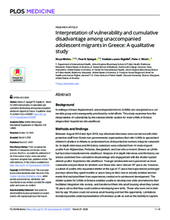Abstract
Background
In settings of mass displacement, unaccompanied minors (UAMs) are recognized as a vulnerable group and consequently prioritized by relief efforts. This study examines how the interpretation of vulnerability by the national shelter system for male UAMs in Greece shapes their trajectories into adulthood.
Methods and findings
Between August 2018 and April 2019, key informant interviews were carried out with child protection staff from Greek non-governmental organizations that refer UAMs to specialized children’s shelters in Athens to understand how child protection workers interpret vulnerability. In-depth interviews and life history calendars were collected from 44 male migrant youths from Afghanistan, Pakistan, Bangladesh, and Iran who arrived in Greece as UAMs but had since transitioned into adulthood. Analysis of in-depth interviews and life history calendars examined how cumulative disadvantage and engagement with the shelter system altered youths’ trajectories into adulthood. Younger adolescents were perceived as more vulnerable and prioritized for shelters over those who were “almost 18” years old. However, a subset of youths who requested shelter at the age of 17 years had experienced prolonged journeys where they spent months or years living on their own in socially isolated environments that excluded them from experiences conducive to adolescent development. The shelter system for UAMs in Greece enabled youths to develop new skills and networks that facilitated integration into society, and transferred them into adult housing when they turned 18 years old so that they could continue developing new skills. Those who were not in shelters by age 18 years could not access adult housing and lost this opportunity. Limitations included possible underrepresentation of homeless youth as well as the inability to capture all nationalities of UAMs in Greece, though the 2 most common nationalities, Afghan and Pakistani, were included.
Conclusions
Due to the way vulnerability was interpreted by the shelter system for UAMs, youths who had the greatest need to learn new skills to facilitate their integration often had the least opportunity to do so. To avoid creating long-lasting disparities between UAMs who are placed in shelters and those who are not, pathways should be developed to allow young adult males to enter accommodation facilities and build skills and networks that facilitate integration. Furthermore, cumulative disadvantages should be taken into account while assessing UAMs’ vulnerability. Following UAMs’ trajectories into early adulthood was critical for capturing this long-term consequence of the shelter system’s interpretation of vulnerability.

